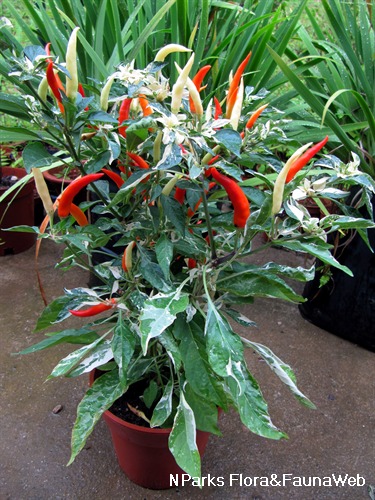
Back
Capsicum chinense Jacq.
| Family Name: | Solanaceae |
| Common Name: | Habanero Pepper, Bonnet Pepper, Datil Pepper, Piri-Piri Pepper, Squash Pepper, 黄灯笼辣椒 |
Name
Classifications and Characteristics
| Plant Division | Angiosperms (Flowering Seed Plants) (Dicotyledon) |
|---|---|
| Plant Growth Form | Shrub |
| Lifespan (in Singapore) | Annual |
| Mode of Nutrition | Autotrophic |
| Plant Shape | Irregular |
| Maximum Height | 0.3 m to 0.8 m |
| Maximum Plant Spread / Crown Width | 0.3 m to 0.6 m |
Biogeography
| Native Distribution | Brazil, Colombia |
|---|---|
| Native Habitat | Terrestrial |
| Preferred Climate Zone | Tropical |
| Local Conservation Status | Non-native |
Description and Ethnobotany
| Growth Form | Herbaceous perennial up to 0.8 m tall. |
|---|---|
| Foliage | Light to medium green leaves are typically egg-shaped (up to 15 cm long, 10 cm wide). The leaf surface is crinkled. |
| Flowers | Star-shaped flowers are composed of greenish white, egg-shaped petals. |
| Fruit | Fruits vary considerably in terms of size and shape (0.6 - 12.7 cm long). They may be long and thin or short with rounded edges. |
| Cultivation | This species is attacked by pests common to tomatoes, peppers, and eggplants, so try not to re-plant the same area with these types of plants. |
| Etymology | The specific epithet 'chinense' means that the plant comes from China. However, this species is actually native to Brazil and Colombia. |
| Ethnobotanical Uses | Edible Plant Parts : Edible Fruits, Edible Seeds Food (Herb or Spice): The fruits are intensely spicy. |
Landscaping Features
| Landscape Uses | Container Planting |
|---|---|
| Thematic Landscaping | Economic Garden |
Plant Care and Propagation
| Light Preference | Full Sun |
|---|---|
| Water Preference | Moderate Water |
| Rootzone Tolerance | Drought Tolerant, Well-Drained Soils, Fertile Loamy Soils |
| Propagation Method | Seed |
Foliar
| Mature Foliage Colour(s) | Green, Green - Light Green |
|---|---|
| Mature Foliage Texture(s) | Crinkled / Twisted |
| Foliar Type | Simple / Unifoliate |
| Foliar Attachment to Stem | Petiolate |
| Foliar Shape(s) | Non-Palm Foliage (Ovate) |
| Foliar Venation | Pinnate / Net |
Floral (Angiosperm)
| Flower & Plant Sexuality | Bisexual Flowers |
| Flower Colour(s) | White |
|---|---|
| Flower Grouping | Cluster / Inflorescence |
| Flower Location | Axillary |
| Flower Symmetry | Radial |
| Individual Flower Shape | Stellate / Star-shaped |
| Flowering Habit | Polycarpic |
| Inflorescence Type Remarks | Flowers typically occur in clusters of 2 or more in the leaf axils (the angle between the upper surface of the leaf and the stem). |
Fruit, Seed and Spore
| Mature Fruit Texture(s) | Smooth |
|---|---|
| Fruit Classification | Simple Fruit |
| Fruit Type | Fleshy Fruit , Non-Accessory Fruit |
Image Repository
Others
| Master ID | 31571 |
|---|---|
| Species ID | 5970 |
| Flora Disclaimer | The information in this website has been compiled from reliable sources, such as reference works on medicinal plants. It is not a substitute for medical advice or treatment and NParks does not purport to provide any medical advice. Readers should always consult his/her physician before using or consuming a plant for medicinal purposes. |










